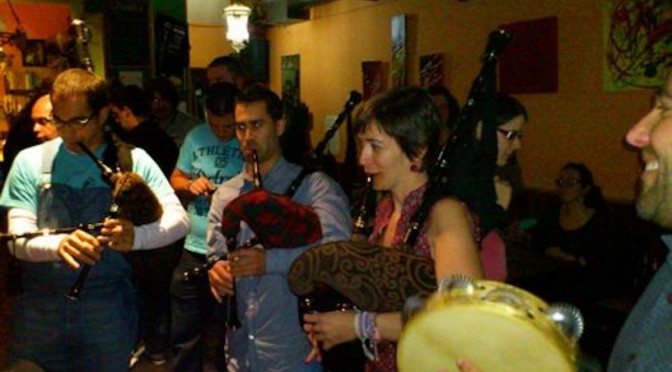Ethniticity
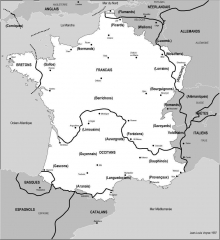 Ximene has a legitimate claim to much of what is now the departement of Languedoc Rousillion in Southern France. The claim was in fact less than one half of the area, which could clain a unique identity under the name of Occitan.Linguists, historians, archeologists and cultural analysts all make a major division between Franks, more recently Francais, and Occitans. Both of these ethnic groups occupy what is now modern France. There are also speakers of an Occitan dialect in northern Italy and strong similarities with the Catalan language and culture in Northern Spain.
Ximene has a legitimate claim to much of what is now the departement of Languedoc Rousillion in Southern France. The claim was in fact less than one half of the area, which could clain a unique identity under the name of Occitan.Linguists, historians, archeologists and cultural analysts all make a major division between Franks, more recently Francais, and Occitans. Both of these ethnic groups occupy what is now modern France. There are also speakers of an Occitan dialect in northern Italy and strong similarities with the Catalan language and culture in Northern Spain.
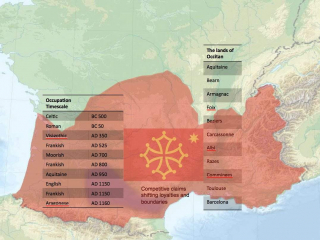 The ownership of the lands below the Loire and west of the Rhone was less well defined than anywhere else in Europe. Couple that fact with the prevalence of support for the Cathar faith in this area meant that there was always the potential for war.In the 14th century the ownership of the lands below the Loire and west of the Rhone were no better defined than anywhere else in Europe. Couple that with the fact with the prevalence of support for the Cathar faith in this area meant that there was always the potential for war.
The ownership of the lands below the Loire and west of the Rhone was less well defined than anywhere else in Europe. Couple that fact with the prevalence of support for the Cathar faith in this area meant that there was always the potential for war.In the 14th century the ownership of the lands below the Loire and west of the Rhone were no better defined than anywhere else in Europe. Couple that with the fact with the prevalence of support for the Cathar faith in this area meant that there was always the potential for war.
As has been detailed in “Feudal Anarchy” at the level of the Comtes there were continual negotiations, oths of fealty could be change in return for impoved status or better taxation rights.
However at a lower level it nationhoods were developed by recognition of distinct characteristics. Was Occitan, or Aquitaine for that matter ever qualified for nationhood? consider the following factors
Language
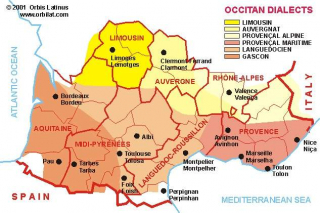 Greater Occitan could be subdivided into provinces according to the dialect of the Occitan language spoken in each districtIn 2008 I was in a Pyrenean Ski resort enjoying the atmosphere of a crowded bar, when I realised that the conversation bouncing around me was in Occitan not French!
Greater Occitan could be subdivided into provinces according to the dialect of the Occitan language spoken in each districtIn 2008 I was in a Pyrenean Ski resort enjoying the atmosphere of a crowded bar, when I realised that the conversation bouncing around me was in Occitan not French!
So even today a different language is spoken. It did not really surprise me, as I lived for a long time just outside Chester, on the welsh Border and at weekends in restaurants and night clubs, speakers of the Welsh Language are not uncommon.
The difference is that the French government until quite recently placed great emphasis on “unification’ of Language. Some would say the policy has not changed.
The language spoken in the north of the French peninsula and adopted by the Franks themselves was “Langue d’oil” where the word for “yes” is “Oui”, basically modern French. In the souther part of the peninsula a totally different language was spoken, “Langue d’oc” where the word for “yes” is “Oc”.
It is a feature of well established languages that there are discernible dialects. Much of the modifiation occurred during the time of the Roman empire but accelerated when there was no need for uniformity across the Empire.
There are at least seven dialects of Occitan all of which at one time were potentially separate languages.
Mutual Defence
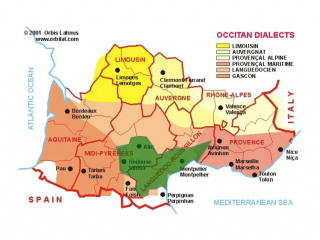 When Ximene was born the part of Occitan she inherited was loosely controlled by the Franks.However at the time of the Albigensian crusade (150 years earlier) the whole of the area shown as green swore allegence to Aragon and resisted the crusaders. It is not often talked about but the English empire also resisted the crusaders and helped to preserve the Occitan culture.
When Ximene was born the part of Occitan she inherited was loosely controlled by the Franks.However at the time of the Albigensian crusade (150 years earlier) the whole of the area shown as green swore allegence to Aragon and resisted the crusaders. It is not often talked about but the English empire also resisted the crusaders and helped to preserve the Occitan culture.
Delineated by natural features
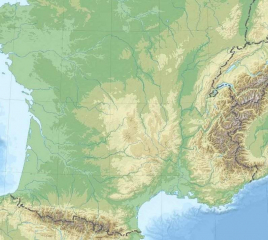 Rivers and mountains protected the south. the weakness was down the rhone valley in the east. A narrow passage with English held territory on one side and the Empire on the other. Nevertheless this is the way the crusaders came and the rote they used to destabilise Aquitane at the time of Ximene.
Rivers and mountains protected the south. the weakness was down the rhone valley in the east. A narrow passage with English held territory on one side and the Empire on the other. Nevertheless this is the way the crusaders came and the rote they used to destabilise Aquitane at the time of Ximene.
Culture And Religion
Culture and Religion went together; the jongleurs, the troubadors, the courts of love, but also the separation of the material world, as evil, from the spiritual world, as good.
Our view of how these concepts were applied is bases in the main on information released by the inquisition and there objective was to demonise the Cathar beliefs.
Cathars did not venerate the cross. They believed that sexual pleasure was not sinful, indeed it was a gift from god to show us what pleasure union with the universal power would bring. A saying attributed to the Cathars is that ” you cannot sin below the waist’. These concepts lead to the concepts of ” Progression” when a young person was accepted as an adult and “Transition” when the young person was given instruction and practical experience of how to give and receive sexual pleasure.
Despite this acceptance of sexual the thoughtless conception of children was considered to be sinful, for every child brought into the devil’s kingdom brought a portion of the good god into an evil world. The net result was that Cathars had relatively few children and the children they did concieve were considered to be “the good god’s heroes”, the minimum required to carry the Cathar faith into the next generation. This meant however, that there were few big families from which military forces could be drawn. This was in direct contrast with nations who followed the Roman faith where the law of primagenture meant that there were many children without inheritance prepared to seek their fortune in military action.
Cathars also, had contrasting liberal laws of inheritance. They made no distinction between male and female , no distinction between eldest and youngest, no distinction between legitimate and illegitimate. In consequence territorial rights were subdivided and then rejoined by marriage, but in ever shifting combinations. In the face of concerted external pressure this lead to dynastic and territorial instability.
The Independance Movement
Many of the best rugby players in modern day France are Occitan. when they play in the french team, their only way of achieving international status, they refuse to sing the Marseillaise.
There is a Political party , Occitan Nationalist Party (PNO). Their current manifesto is relatively modest- increased regionalisation so that the occitan culture and in particular the language can be revived.
Try telling these people that occitan never existed!
Despite what the French government may say there is a clear pattern of independence and nationhood for Aquitaine which represents more than half of the total area of Occitan.
Nevertheless Something Ximene did not know is that the Black Prince’s claim to Occitan was probably better than her own.
dialects
 Greater Occitan could be subdivided into provinces according to the dialect of the Occitan language spoken in each district It is a feature of well established languages that there are discernible dialects. Today there are around twenty five romance languages derived from the same vulgar latin root stock. Much of the modifiation occurred during the time of the Roman empire but accelerated when there was no need for uniformity across the Empire.
Greater Occitan could be subdivided into provinces according to the dialect of the Occitan language spoken in each district It is a feature of well established languages that there are discernible dialects. Today there are around twenty five romance languages derived from the same vulgar latin root stock. Much of the modifiation occurred during the time of the Roman empire but accelerated when there was no need for uniformity across the Empire.
Both French and Occitan are romance languages, Occitan is also known as Langue d’Oc, as the word for yes is “Oc”. French is also known as Langue d’Ouil as the word for yes is “Oui.”There are at least seven dialects of Occitan all of which at one time were potentially separate languages.
The spread of these dialects gives a strong indication of the boundaries of the existence of a separate ethnic group.
The Celts
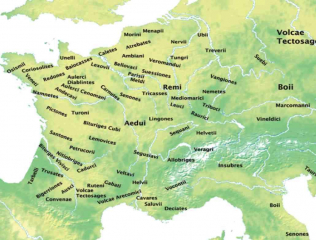 The existance of a separate language and its various dialects must mean that there genetic or administrative differences beteen Norther and Southern France. For a long period the whole of what we now call France was occupied by Celtic tribes,known to the Romans as Gauls.
The existance of a separate language and its various dialects must mean that there genetic or administrative differences beteen Norther and Southern France. For a long period the whole of what we now call France was occupied by Celtic tribes,known to the Romans as Gauls.
The celtic peoples stretched from the Atlantic Coastline to Anatolia (now Turkey) and from the tip of Scotland to the North African coast. (See The Gallic Empire)
Romans
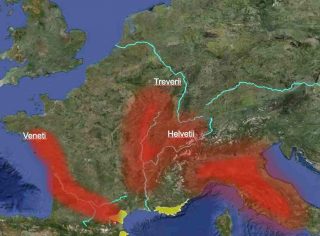 The Roman conquest of Gaul, despite Caesar’s writings, was initially more about extending trade and obtaining access to precious metals that pure territorial gain. As a springboard, the Romans used the Greek trading states which they had taken under their protection. Initially the extended along the Garronne river to give access to the Atlantic and up the Rhone and Soane rivers to give access to the North sea. Any Gauls who co-operated (the Treverii) were accepted as trading partners given Roman citizenship and a degree of autonomy including their own senate. Any who obstructed were however severely disciplined (the Helvetii).
The Roman conquest of Gaul, despite Caesar’s writings, was initially more about extending trade and obtaining access to precious metals that pure territorial gain. As a springboard, the Romans used the Greek trading states which they had taken under their protection. Initially the extended along the Garronne river to give access to the Atlantic and up the Rhone and Soane rivers to give access to the North sea. Any Gauls who co-operated (the Treverii) were accepted as trading partners given Roman citizenship and a degree of autonomy including their own senate. Any who obstructed were however severely disciplined (the Helvetii).
In general the Roman invasion did little to displace these independent Gallic Tribes. Celts were still running the Roman government and administration 500 years later (see The High Kings) eventually accepted the inevitable and took well to life under Roman rule though they always searched for ways to retain a measure of independance.
Breakdown
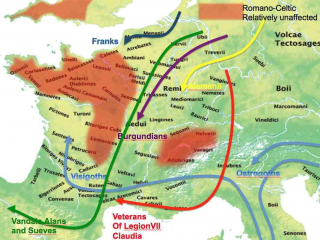 Eventually central Roman control broke down. There were a series of invasions and the movement of whole populations. Local lords (Counts) emerged to protect local interests and this system became institutionalised.
Eventually central Roman control broke down. There were a series of invasions and the movement of whole populations. Local lords (Counts) emerged to protect local interests and this system became institutionalised.
The counts could be drawn from the Romano-Celtic administrators, from the local Celtic stock or from members of the migrating peoples.
It made little difference, members of the ruling families intermarried creating a ruling class with an extensive gene pool.
Romano Celtic Stock
The romano-celtic structure survive almost everywhere. In Brittany; along the band between the loire and the channel coast and into the high mountains of Auvergne the roman administration was almost untouched. This area was under the general leadership of Count Syagrius. His state lasted for over twenty years.
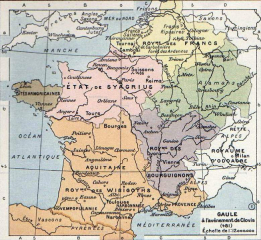 The "kingdom" of SyragiusThe area to the west of the Rhone and to the south of the Loire was settled by the Visigoths and the area to the east of the Rhone and to the south of the Danube was settled by the Ostrogoths.
The "kingdom" of SyragiusThe area to the west of the Rhone and to the south of the Loire was settled by the Visigoths and the area to the east of the Rhone and to the south of the Danube was settled by the Ostrogoths.
It is in the western part of this vast area that the alternative the Occitan language is still spoken today.The Goths must contributed to the way in which the occitan language (langue d’oc), though derived from Latin had so many differences from the language spoken further north (langue d’oil)
Religious Differences
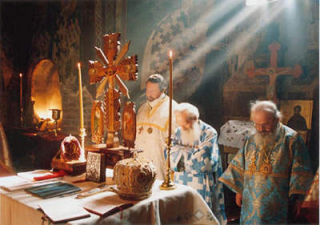 During the latter years of central Roman control religion had become a preoccupation for goverment and the people.
During the latter years of central Roman control religion had become a preoccupation for goverment and the people.
Although Constantine had made Christianity legal and Theodosius had made it the state religion, there were many different strands of christian belief. At the time of the great migrations there were at least seven religious persuasions.
The Orthodox faith was practised in the still thriving Roman empire of the east, based in Constantinople (Byzantine Empire).
The Coptic faith was practiced in Egypt (also part of the Byzantine Empire)
The Church of Rome, which had broken away from the Orthodox church in order to seek support from the Western Emperors, propagated it’s teaching throughout Western Europe.
The Arian Church, which had been declared heretical by both the Orthodox and Roman churches, and driven from the empire, but had thrived outside the boundaries and was now being reintroduced to the empire by the migrations.
The Celtic Church was different again, so different that it sent missionaries to Europe to try and convert members of the Church of Rome to the “true faith.”
Pagans
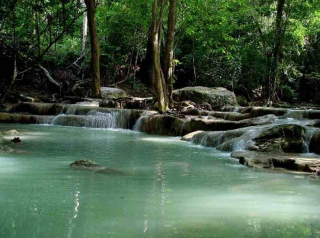 The christian world jointly referred the followers of the ancient gods “pagans” but the ihe majority of the celtic population in the countryside still worshipped the celtic gods. The Celts worshipped nature, particularly forests and water bodies, rather than gods.
The christian world jointly referred the followers of the ancient gods “pagans” but the ihe majority of the celtic population in the countryside still worshipped the celtic gods. The Celts worshipped nature, particularly forests and water bodies, rather than gods.
The Celtic religion was attacked by the Romans but eventually when the influence of the druids had been removed they accepted many aspects of the celtic beliefs, as they had done with many other religions. there is documentation of continued pagan worship in papal communication with Queen Brunhilda (590) and Charlemagne is credited with cutting down the yggdrasil or world tree, worshipped by the Saxons(770)
Roman Gods
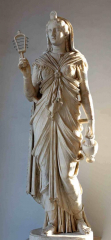 The top level of society and in particular, members of the senate, worshipped the traditional Roman gods.
The top level of society and in particular, members of the senate, worshipped the traditional Roman gods.
In 390 at the battle of the Frigidus, the Eastern Emperor Theodosius defeated the Western Emperor Eugenius in a battle whose underlying cause was the fight for the supremacy of christianity over paganism. The battle inflicted disastrous losses on both sides; losses so great that Roman military capability was severely depleted.
Despite this victory, the mass destruction or takeover of the shrines to the ancient gods was only possible one hundred years later after Clovis rise to power. The worship of Isis, an Egyptian goddess adopted by Rome, persisted possibly as late as the date of the building of Notre Dame in Paris(1163), which is reputed to have incorporated some elements of a previous temple in honour of Isis.
Clovis’ “Sacred” task
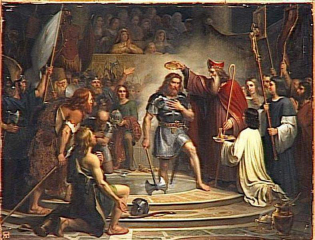 Clovis, King of the Franks, though he may have been a pagan or an arian, quite possibly both, gained enormous political advantage by aligning himself with the Church of Rome.
Clovis, King of the Franks, though he may have been a pagan or an arian, quite possibly both, gained enormous political advantage by aligning himself with the Church of Rome.
It became Clovis sacred task to conquer his Arian neighbours and impose the beliefs of the Church of Rome on them. In return for supporting his cause the Church of Rome became the administrative arm of the Frankish government.
See also History of Occitan-Aquitaine
